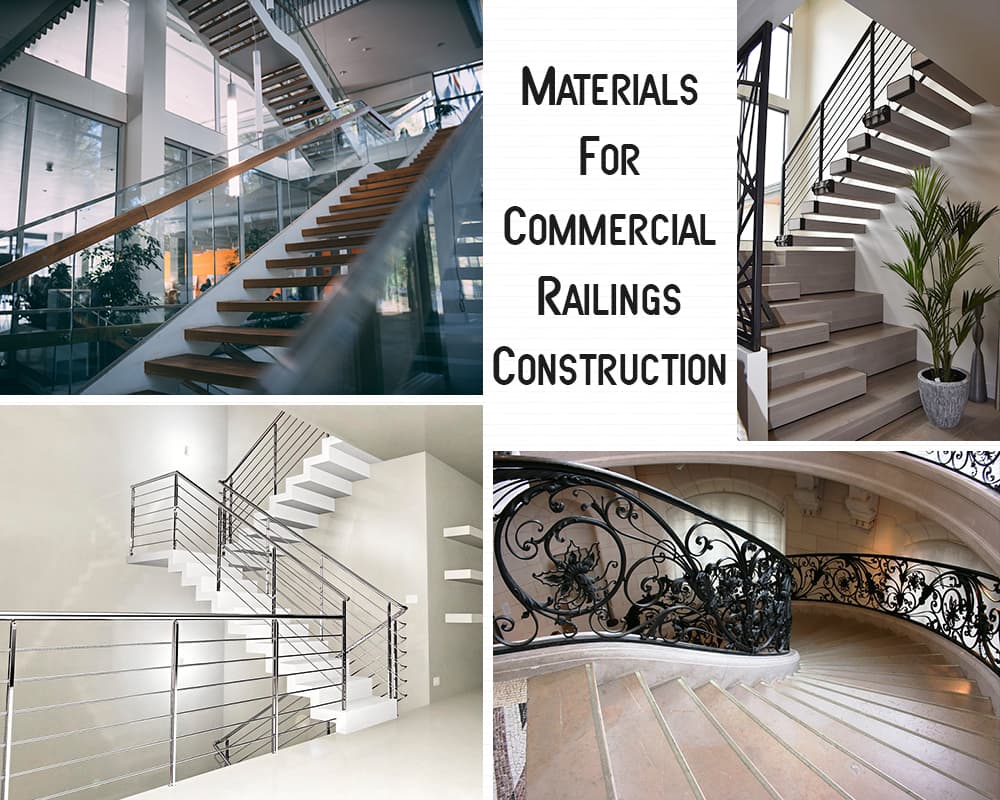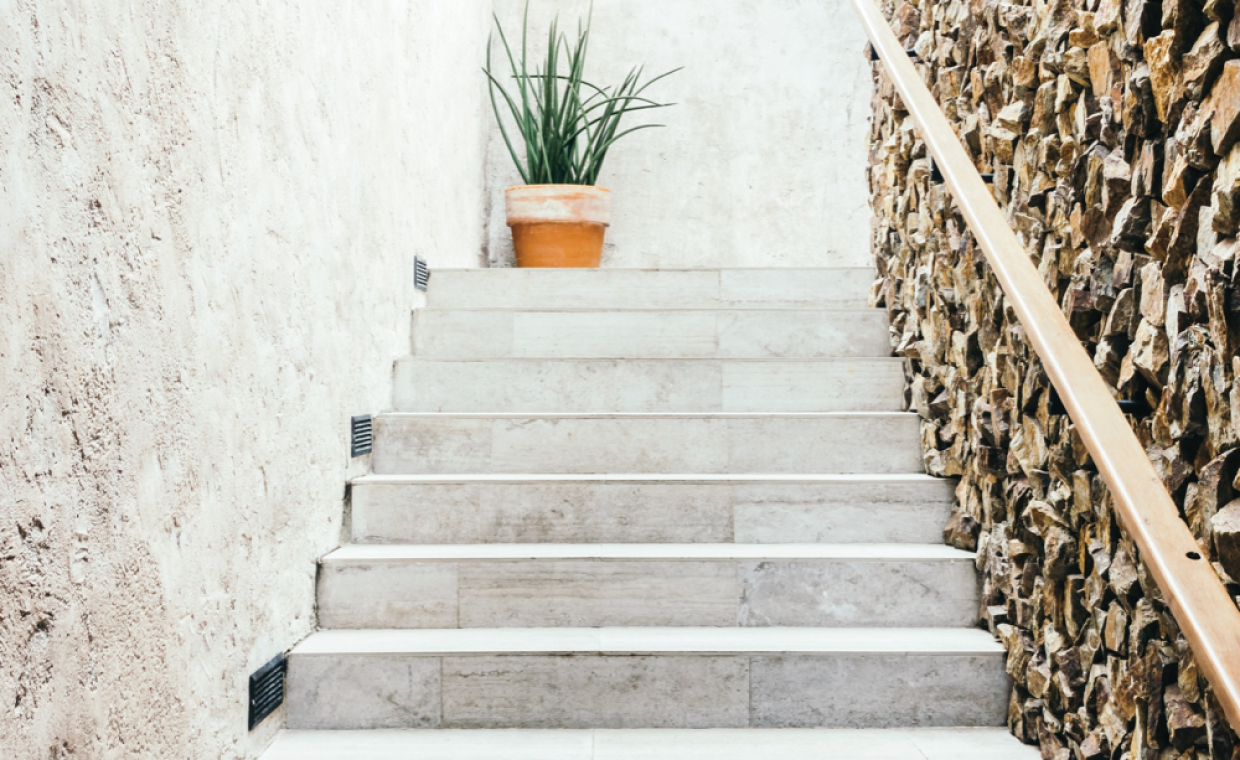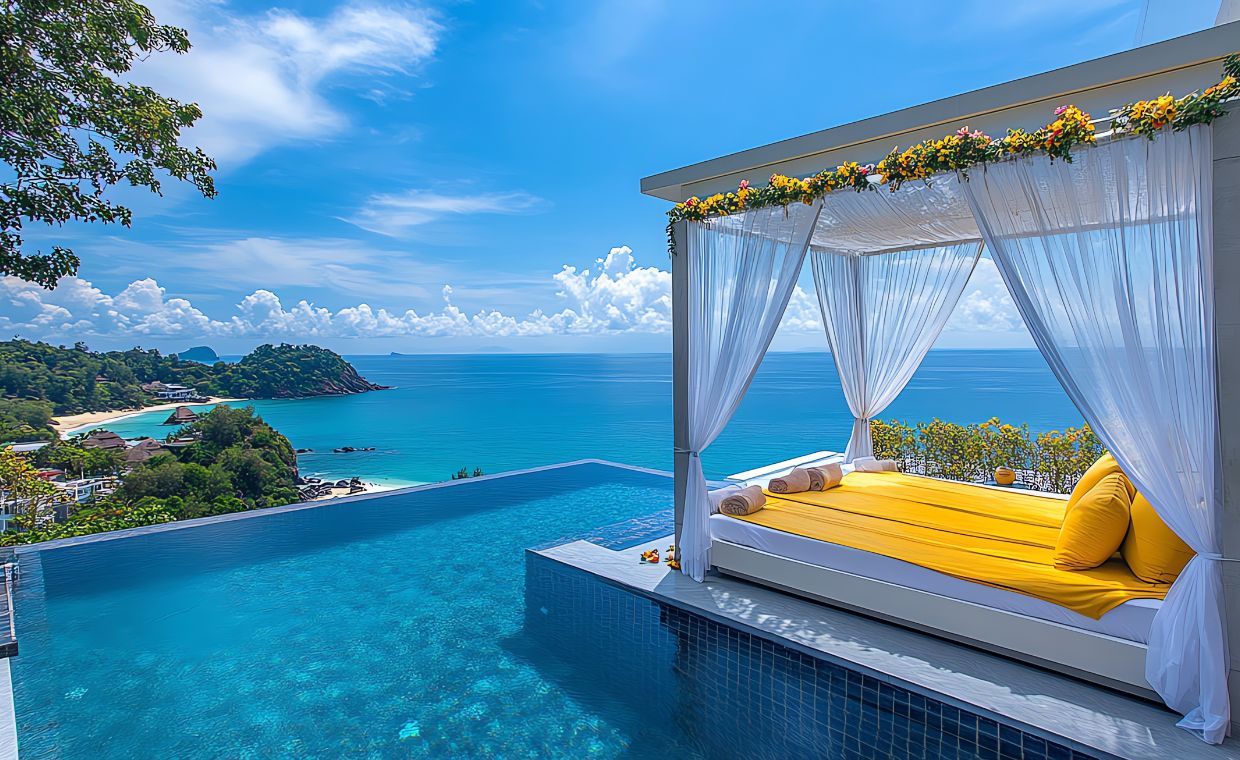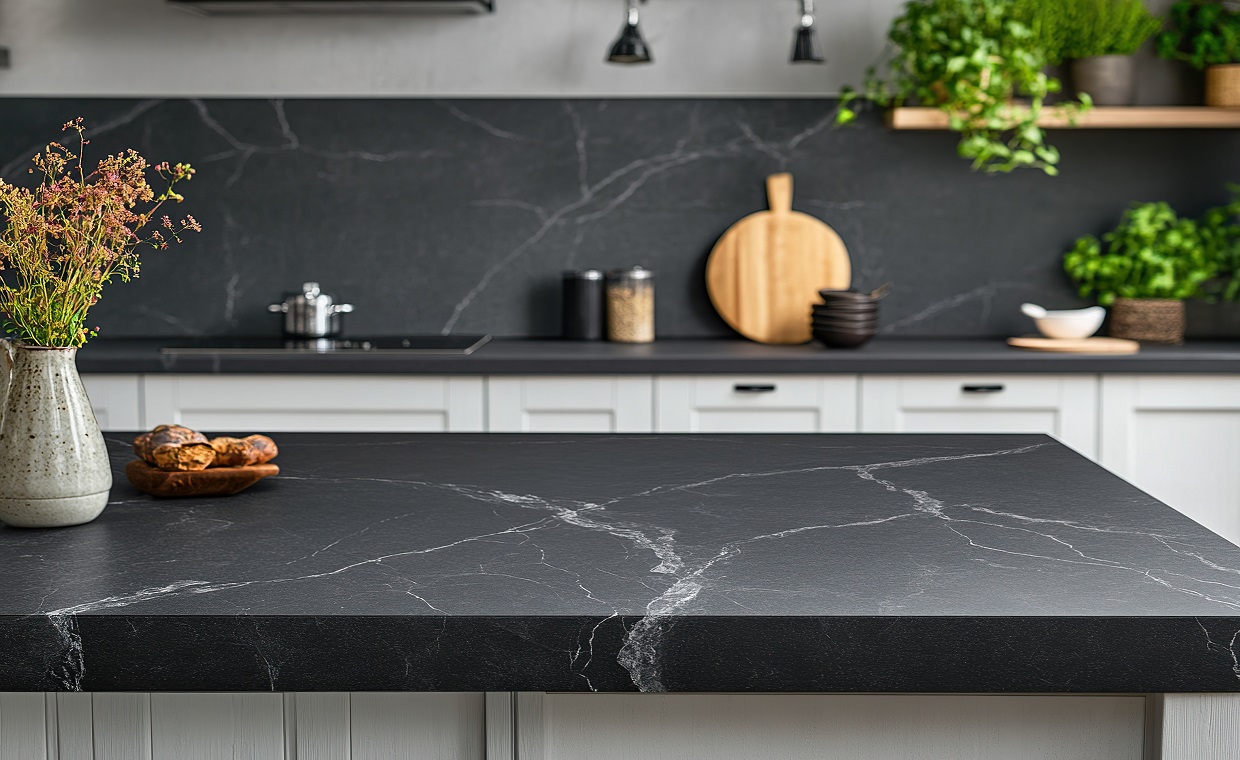
The railing and handrails are important safety features on commercial staircases and balconies. Architects/contractors have to use the right materials to ensure they work properly and provide the necessary protection. In some cases, the material used has to be both aesthetically pleasing and functional.
There are various types of railing materials available on the market. To select the railing material, you must first understand its characteristics, its cost, durability, maintenance requirements etc. We, at GharPedia aim to provide information on various railing materials.
Types of Railing Material for Commercial Buildings
There are different types of railing materials available. Here is a brief overview of popular railing materials, including their cost, durability, maintenance, installation and aesthetics.
01. Aluminum Railing

Aluminium is a naturally occurring metal with a lower density than the majority of other metals used in commercial applications. This makes it a better alternative to steel, especially when weight is a huge consideration. Aluminium is one of the most cost-effective metals that can be 100% recycled without compromising on the quality of the finished product (Misra, 2017). Aluminium also has the added advantage of being resistant to rust and corrosion from common elements and corrosive materials without the need for additional treatment. All of these qualities combine to make aluminum an ideal choice for companies such as Trex Commercial, which uses it in a variety of settings such as stairs, resort projects, condominiums, and more.
(a) Cost
Railing costs usually vary from manufacturer to manufacturer, but aluminium railing is more affordable and less expensive than other types of railings. The cost of aluminium railing varies from INR 600/feet to INR 1000/feet.
(b) Life
Unlike other types of railings, aluminium railing does not corrode or deteriorate. If cleaned and maintained properly, powder coated aluminium railing can last 20 to 40 years.
(c) Maintenance
Aluminium railings require minimum maintenance. They do not rust or flake, as aluminium is a non-ferrous material. You don’t have to worry about repainting the railing. If it appears dirty, simply clean it with soap and water. Aluminium railings tend to corrode in coastal areas. When coastal salty airs come into contact with aluminium, it forms a white coating of aluminium oxide and unpleasant pitting is formed on the surface of Aluminium. Powder coating is an effective way to protect aluminum from salt water and air.
(d) Installation
Aluminium railing installation is simple and does not require the use of heavy equipment. Aluminium is lightweight and is easy to transport to construction sites. Miter saws are ideal for cutting aluminium. There is now an easy-to-assemble aluminium railing kit available, making it a fun DIY project.
(e) Aesthetics
Aluminium makes for beautiful railings. Aluminium railing is available with powdered coating, which adds luster and protects it from environmental factors. It is available in a variety of colours to match the interior décor of your house.
Pros and Cons of Aluminium Railing
Pros:
- Like steel, aluminium is extremely strong and durable, and it can be used to create a very safe environment.
- Aluminium is resistant to even the harshest weather conditions and requires little maintenance.
- Aluminium is much lighter than steel, making it easier to install and more suitable for do-it-yourself projects.
- Aluminium is also easier to cut and form than steel due to its lighter weight.
- As a result, it comes in a wider range of designs and patterns.
- Powder coating aluminium railings provides a variety of colour options
Cons:
- The main disadvantage of using aluminium for railings is that it is more expensive than steel. Aluminium railings are also more prone to denting and scratching than steel.
02. Steel Railing

Steel, along with cement, remains one of the most popular and widely used building materials. It is strong, despite being much denser than many of the other metals used in industrial applications. Steel’s versatility allows it to be used in industrial staircases, egress stairs, and stair stringers.
The one downside to using steel is that it is prone to rust. This means that contractors have to use stainless steel in applications where the metal will be exposed to the elements. Steel is made more rust-resistant by incorporating nitrogen, nickel, molybdenum, and chromium into it.
(a) Cost
The cost of steel railing ranges from INR 400/ feet to INR 1200/feet, depending on the grade of steel used. Stainless steel is costlier as it requires less maintenance.
(b) Life
Steel railings are stronger and more stable than wood railings because of their higher tensile strength. It can withstand heavy loads without sustaining any damages. Steel railings can last a lifetime with proper care.
(c) Maintenance
The maintenance of steel railing depends on the grade of steel used in it. Stainless steel requires less maintenance than other metals. Low grade steel is more susceptible to corrosion. Steel railings need to be repainted as the paint can flake over time. If the railings appear dirty, simply wipe them down with a damp cloth and they will be as good as new. Steel does not bend, warp or crack. Steel railings can endure inclement weather.
(d) Installation
Steel railings are heavy and difficult to install. Transportation and handling sometimes require heavy items. Skilled welders are required for the installation of steel balustrades. Due to the weight and complexity of installation, it is recommended that the steel railings are installed by professionals.
(e) Aesthetics
Steel railing instantly gives your structure a modern, sleek and minimalistic look. Many modern houses use stainless steel railings as they have a gleaming surface. It easily combines with glass or wires without complicating the design. However, there is not much scope for customization in the design of steel railings.
Pros and Cons of Steel Railing
Pros:
- Steel is one of the safest materials for railings because it is extremely strong and long-lasting.
- Galvanized and stainless steel are low-maintenance materials that can be cleaned with a sponge and mild detergent.
- Steel is a versatile and weatherproof material that can be used both inside and outside.
Cons:
- Steel can buckle and weaken in high temperatures.
- They can cost more than wood or other materials.
- Due to its weight, steel may be a difficult material to use for DIY projects.
- Steel is also difficult to install due to its weight, and on-site adjustments require specialised equipment.
03. Glass Railing

Although glass is commonly used in residential settings, it has seen greater adoption in commercial settings such as resorts and stadiums in recent years. Glass might not appear to be a safe or obvious choice because it is brittle and therefore prone to shattering, but it is far tougher than it is perceived to be. Glass can be clear, transparent, frosted or etched.
In normal stair applications, other types of railing materials, such as metal or wood, are used for the handrails, while glass is used for the main structure. Stainless steel handrails are most common with glass railings. The glass can also be framed to add rigidity and improve aesthetics, or it can be left unframed.
(a) Cost
Glass railings are more expensive than other types of railings. If common glass is used, the cost of glass railing in India ranges from INR 1200/feet to INR 2200/feet. Toughened or tempered glass, which is expensive, is used for high safety. It costs between INR 3000/feet to INR 4500/feet.
(b) Life
Float glass railing has a long lifespan for indoor applications. Toughened or tempered glass railing, on the other hand, is more secure. It is three times stronger than float glass. Hence, it is the best option for outdoor applications that are subjected to frequent storms or bad weather conditions.
(c) Maintenance
Glass railings do not require a lot of upkeep. Glass can withstand environmental factors. It does not show signs of wear or cracking. It can be restored to like-new condition by simply cleaning it with soap and water. Cleaning glass railings becomes more important in high-traffic areas as fingerprints are imprinted on the surface on a daily basis. Keep an eye out for scratches on glass. Polishing is required to restore the quality of the glass railing when it has heavy scratches.
(d) Installation
It is critical to take precise measurements of the space when installing glass railings, so it is best to hire trusted professionals. The quality of the hardware holding the glass should never be neglected because it affects the overall safety of the railing system.
(e) Aesthetics
Glass railing adds openness and visibility wherever it is installed. It allows natural light, which brightens the interiors. It complements the minimalistic style of interior design perfectly. Glass railing systems offer a variety of designs to meet your requirements. Transparent glass is commonly used, but the design cannot be customized. If you want more privacy, you can opt for frosted glass or lacquered glass. Glass railings add a modern touch to your interiors.
Pros and Cons of Glass Railings
Pros:
- Glass railings provide a safe barrier while not blocking the view.
- They can make a room appear larger because they let in natural light.
- Glass railings can act as a wind barrier when used outdoors.
- Glass railings are easy to maintain.
Cons:
- Although glass is simple to clean, it must be done on a regular basis because dirt and fingerprints can appear quickly.
- Glass railings are transparent and can cause mishaps when birds, animals, and even people collide against them.
- Glass is relatively heavy and, if not handled properly, can crack during installation. As a result, it is likely that it is best installed by a professional.
We have an exclusive guide on different types of glass:
04. Wrought Iron Railings

Wrought iron is an iron alloy with a low carbon content. It has less than 0.15% carbon (Bhavikatti, 2012). In the 1800s, the demand for wrought iron grew as the demand for a malleable metal that made it easier to complete projects increased. Although wrought iron is no longer mass-produced, it is still useful in the restoration of old works or in projects that require the unique look of wrought iron.
Wrought iron is used in both indoor and outdoor staircases in residential and commercial projects. Contractors use iron for the balustrades and wood for the handrails to create a dramatic look.
Contractors can select from a variety of materials for staircases in commercial buildings. In many cases, the railing material chosen has to provide the required level of protection and assistance. However, in others, the material is chosen for aesthetic reasons.
(a) Cost
Getting customized wrought iron railings can be a costly affair. They are difficult to make and very expensive to customize. The cost of wrought iron railing ranges from INR 1200/feet to INR 2400/feet.
(b) Life
Wrought iron is a strong material with high tensile strength. It can withstand heavy traffic. Once you install powder-coated iron railings, you can expect them to last for a minimum of 60 years. With proper maintenance, they can last a lifetime.
(c) Maintenance
Wrought iron railings are said to be rust resistant, but it depends on the quality. Powder coating the railings significantly reduces the amount of maintenance required. It is easy to clean them: all you need is mild soap and water to remove the dust. Corrosion should be checked on the railings. If corrosion is found, clean it and recoat it and the railings will be as good as new. In areas with high rainfall and humidity, it is recommended that the railing be repainted or given a protective coat as often as possible to ensure its longevity.
(d) Installation
Installation of wrought iron railings is challenging and best left to professionals. It requires special tools and equipment. Railings must be handled and transported with caution. Railings must be installed by skilled welders. Hence, professional installation is recommended for wrought iron railings.
(e) Aesthetics
Many wrought iron railings are over 200-years-old and still in use. They provide a timeless appearance to your structure. Wrought iron can be molded into any shape, allowing for a wide range of railing designs. Wrought iron railings are customizable, which is one of their major advantages. They are not mass-produced and are unique for a specific project. They are handcrafted with special tools and are one-of-a-kind.
Pros and Cons of Wrought Iron Railings
Pros:
- One of the primary benefits of wrought iron is that it’s versatile. Because it is malleable, it can be used to create an infinite number of looks.
- Wrought iron provides stability and strength to staircases due to its strength.
- Powder coating can be used to keep wrought iron railings in good condition.
Cons:
- Due to the fact that it is custom-made, wrought iron is generally more expensive than other materials.
- Due to its weight, wrought iron can be difficult and time-consuming to install, increasing labour costs.
- Weather exposure can cause wrought iron to rust, if not properly maintained. Wrought iron must be recoated and repainted on a regular basis to prevent rust.
05. Wood Railing

Railings are made from a variety of woods. Commonly used woods are cypress, mahogany, teak, oak and pine. Wood railing gives a warm aesthetic with natural wood grain pattern. The wood railing softens the elements visually. It is preferred for low-rise buildings, as it is not as sturdy as metal.
However, not all wood manufacturers make railing, as it requires frequent maintenance. Wood is susceptible to frequent warping and bowing. Hardwoods are suitable for outdoor railings, whereas softwoods can do well in interior applications.
(a) Cost
The cost of wood railing depends on the type of wood used. Hardwoods are more expensive than softwoods. The typical cost of simple, uncarved wood railings ranges from INR 2000/sq. ft. to INR 4000/sq. ft. If one requires custom designs, the wood is carved accordingly. The cost of carved wood railing ranges from INR 3500/sq. ft. to INR 5000/sq. ft.
(b) Life:
With regular maintenance, wood can last a lifetime. Hardwoods last longer than softwoods. As wood is prone to termite attack, proper care must be taken to extend its life.
(c) Maintenance
Wood railings require a lot of upkeep. In a moist environment, it is susceptible to warping and swelling. Wood railings need to be stained or painted on a regular basis. Periodic polishing of its surface is also required to maintain its lustre. Softwoods are more prone to scratches, hence they require more maintenance. It is important to check for termites, wood rot, fungus, and other deformations in wood railings as it can ruin them, if not addressed. Wood railings are also difficult to clean due to their porous surface.
(d) Installation
Installation of wood railings is difficult, but with the right set of instructions, it can be a fun DIY project. Wood railing DIY kits are available on the market. It is important to give the wood assimilation time before installation. Professional installation is recommended for complex railing structures.
(e) Aesthetics
Wood railings complement both traditional and modern designs. They add warmth to the structure. Wood railings complement traditional home interior design, but they can also be combined with glass to create a more contemporary look. Wood railing can be customized to meet specific requirements. Carved wood railing gives a royal appearance to your structure.
Pros and Cons of Wood Railing
Pros:
- One of the main benefits of wood railings is the natural beauty they provide to the environment. Because wood can be given any shape, it can be used to achieve a wide range of appearances.
- Wood can also be stained to match your decor or painted any colour you want.
- Wood is a popular choice for do-it-yourself (DIY) remodelling projects because it is typically inexpensive to purchase and install. Wooden handrails and railings are easy to clean and maintain.
Cons:
- Interior wood railings can look dated if not combined with modern materials such as glass or metal.
Read our comprehensive guide to wooden staircases:
06. Marble Railing

Marble is the best for giving timelessness to the house. It is extensively used in areas where it is easily available. Marble railing will give a royal appearance to the building. The glossy, polished finish will enhance the aesthetics of the building. Marble railing is used both inside and outside the building. Marble railing is extremely strong, durable and resistant to heat and fire.
(a) Cost:
Marble is a luxury material that is more expensive than other types of railing materials. The cost of marble railing depends on the type of marble. Italian marble is more expensive than Indian marble. White marble railing costs between INR 3500/sq. ft. to INR 7000/sq. ft., depending on the quality of the marble.
(b) Life
Marble has withstood the test of time, as some famous structures, such as the Taj Mahal, still stand tall today. Marble railings have a long lifespan if maintained regularly. It is extremely strong and can easily take heavy loads. Marble railings have a minimum service life of 50 years. This can be increased with proper maintenance.
(c) Maintenance
Marble is very easy to clean; a mild soap and water mixture will restore its original shine. Marble is soft and susceptible to scratches, hence, abrasive cleaning agents should be avoided. It is not prone to mold, fungus, corrosion etc. It is critical to inspect marble railings every day for outdoor applications because chemical pollutants can react with their surface and stain them. Chemical cleaners can be used to remove mild stains.
(d) Installation
As it is evident that marble is heavy, handling and transportation become complex processes. Special cutting tools are required for cutting marble. Marble railing installation can generate a lot of dust and noise. Marble railings should be installed only by professionals.
(e) Aesthetics
Marble has a distinct beauty. It shines in such a way that it appears to be glowing. It gives your home a rich and luxurious look. Marble railings can be customized to your specifications and carved into different shapes. Some palaces have animal carvings on their marble balustrades, which add a royal touch to the interior.
Pros and Cons of Marble Railings
Pros
- Marble is a symbol of luxury; it can give a rich look to your structure.
- Marble railings are strong and durable. They can last a lifetime if maintained properly.
- Marble railings can be customized to your liking. Marble can be carved into a variety of shapes.
- Marble railings are easy to clean, and are not prone to mold, fungus or corrosion.
Cons
- Marble railings are prone to scratches. Hence, they have to be used cautiously, in structures that are subjected to heavy use.
- They can deteriorate easily when used in outdoor applications due to pollutants in the air. Therefore, they are best suited for interior applications.
- Installation of marble railings is not DIY friendly and should be done by professionals only.
- Marble railings are expensive when compared to other types of railings.
07. Stone Railing

Stone railings are found in historic commercial structures. Stones are sturdy and can withstand extreme weather conditions and heavy traffic. Stone railings can be installed both inside and outside a building. One can design the railing with clean lines and symmetry to make it visually appealing. Stone railings are long-lasting, stain-free, waterproof and sturdy and have a long maintenance-free life. Stone railings can be made from a variety of stones, including yellow sandstone, Jaisalmer stone, granite, quartzite, etc.
(a) Cost
Stone railings are a status symbol. They are expensive when compared to other types of railing. The cost of stone railing depends on the type of stone used. It usually costs between INR 1500/sq. ft. to INR 5000/sq. ft.
(b) Life
Stone railings are sturdy and can withstand heavy loads. They remain the same throughout their lives. Stone railings in religious places are still standing. They have a long lifespan.
(c) Maintenance
Stone railings require almost no upkeep. Wiping with a damp cloth is enough to keep them clean. Mold growth is possible in natural stone in moist environments.
(d) Installation
Stones are heavy; hence, they must be handled carefully during transportation and installation to avoid damage. Drilling in stones must be done carefully, with precision, or cracks may be develop in the stones. Also, the installation process is time-consuming.
(e) Aesthetics
Stone railings can be customized according to your requirements. Installing stone railing is an expensive endeavour. They add an element of luxury to your structure. They are commonly found in palaces, religious places, and historic monuments that have stood for many years. Stone railings are more suitable for European interior styles and will not match modern interior styles.
Pros and Cons of Stone Railings
Pros
- Stone railings are made up of uprights and arc poles, which are generally composed of uprights and poles. The installation has a beautiful and atmospheric effect.
- Any shape, simple or complex, carved or hollow, can be made. You can have whatever you want.
- After a period of use, the stone railing will be polished and mirrored as if it were new, and the service life can be very long.
Cons
- It occupies a lot of space. The columns of the stone railings and handrails, particularly the general column at the top and the large conversion column in the middle, take up a lot of space on the stairs.
- When used indoors, stone railings are generally more appropriate for European, American, French, and other styles. They are less appropriate for modern, simple, and light luxury styles.
- Because of the high cost of stone railings, the average consumer has little desire to consume them.
Stone railings complement stone stairs best; Read more about stone stairs here:
08. Mild Steel Railing

Mild Steel (MS) is popular due to its ease of large scale production. The exterior elements, such as balcony railings, should be able to withstand any kind of natural weather. MS railings are well known for standing during the test. MS railing is also used to enhance beauty, strength and aesthetic appeal because it has a sleek and modern look.
There is a misconception that customizing MS railings is expensive. But, on the other hand, it is affordable to customize railing designs, provided you have a professional fabricator who can do the job effortlessly and effectively. MS railings require regular maintenance.
(a) Cost
MS railing costs less than other types of railing materials. MS railing costs between INR 300/feet to INR 1000/feet. They are very affordable but require more maintenance.
(b) Life
Mild steel railings require frequent maintenance. They have a service life of 20 years. This can be increased by repainting and recoating the railing on a regular basis.
(c) Maintenance:
Mild steel railings require regular maintenance. This material is prone to corrosion due to its low carbon content. As a result, the paint on the railing may flake over time. After a certain number of years, the railing must be repainted and recoated.
(d) Installation
Mild steel railings are difficult to install. Professional installation of the railing is recommended.
(e) Aesthetics
Mild steel railing gives your structure a modern look. It can be painted in a variety of colours to improve its appearance. However, there is little room for customization in the design of mild steel railings.
Pros and Cons of Mild Steel Railing
Pros
- Mild steel railings are less expensive, which is their biggest advantage when it comes to installing them in commercial structures. They can save a lot of building costs.
- Mild steel railing gives a modern and sleek appearance to the structure.
Cons
- Mild steel railing requires high maintenance and regular cleaning. They require regular recoating and repainting too.
- Its installation is not DIY-friendly and must be done by professionals only.
Final Thoughts
Summing up, there are many types of railing materials available in the market for commercial projects. Each material has its own pros and cons. Cost, life, maintenance, installation and aesthetics must all be considered when choosing a railing material. Hope this guide has been helpful in your railing material selection process.
Gharpedia has also conducted research on the various types of railing materials for residential buildings. To learn more, follow the link below–
Best Stair Handrail Design Guide For Your Staircase!
Image Courtesy: Image 7

































